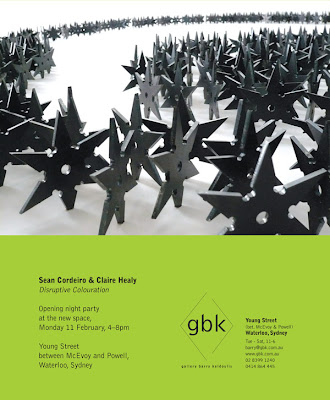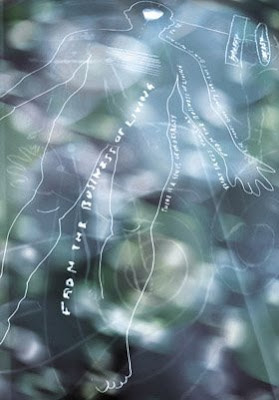From Isobel Johnston…
Things I don’t remember is the title of a song by Ugly Casanova aka Modest Mouse – who happened to be in town at around the same time as the opening of Claire Healy and Sean Cordeiro’s show Disruptive Colouration, the show that launched Gallery Barry Keldoulis’ new space in Young Street in Waterloo. A gallery ‘big enough to hold a Winnebago’ as the saying goes and also incidentally, a space big enough to house a large gallery as well as considerable area to showcase all their artists’ work. The exhibition has finished but new work by Cordeiro and Healy’s forms part of the show Australian at Casula Powerhouse in April.

But at the opening of Disruptive Colouration the song Things I don’t remember just kept going round in my head: “How the hell did we get here? … Disco dancing neighbours who were born of mashed potatoes.” But maybe that’s just what happens after a couple of glasses of wine. It all made total sense – the song lyrics and the exhibition’s rationale merged, conflated and spun off transporting me back to my childhood. This was no doubt due in part to the flat packed Tardis and the outline of a charging white elephant on the back wall of the gallery in ninja stars, which recalled for me both Dr Who and Shintaro the Samurai Warrior.
The Samurai employed the first use of track-in-zoom-out and this was the same pull I was experiencing through the work. Like Alice in Wonderland I was travelling down the proverbial tunnel and flashing before me were all the material things that had ever passed through my hands. The school fetes, the op shops, the junk in my house and at parents and grandparent’s homes bearing down with stampeding force.
“How the hell did we get here?” seems also equally fitting descriptor for Fiona Hall’s major survey, Force Field at the Museum of Contemporary Art. Much of the work I had seen before as it spans work from the last decade or so but something synergetic happens when it is all brought together. It becomes its own taxonomic system of ordering the world, giving an insight into Hall’s vision/brain, methodology, poetry, humour and skill – a renaissance woman armed with tin snips.
At a moment in time when “sub-prime” has the rubric of financial ruin and stock market fluctuations impact on low-income families, the dream of the family home becomes ever more a poisoned chalice. There was one particular image on the TV recently, of an American family living in a caravan with a rose arbour and a fountain salvaged from the middle class suburban garden they had just forfeited. These objects looked shamefully out of place and poignant beside the caravan.

timber, plywood, gold vinyl, scaffolding, macrame, crystal bowls.
Eleanor and James Avery’s recent exhibition Supernova at GrantPirrie seemed to touch on our material dreams as they had hitched macramé hanging baskets filled with assorted cut crystal dishes to their own cardboard star- something light-years away. The star on the Christmas tree will never seem big enough after seeing one that can fill the gallery space. This seems to beg the question- why do we drag around so much stuff? Appeals for being green take the form of the rich buying hybrid cars and movie stars wearing green. Don’t get me wrong, I don’t do much towards the cause but I think a low income is great for controlling the urge to consume.
However, to see any of these shows as proselytising is to miss the point. This is just one point of access in an array of points of access. The gap between the rhetoric and the experience is the space that these artists give us. It is a chance to look at things afresh. It might be the encounter with illuminated Tupperware in Hall’s work The Price is Right which flashes in Morse code Charles Dickens’s adage “I have the misfortune of not being a fool”. Or Healy and Cordeiro’s mashed potato work in which the comestible becomes the medium and is iconoclastically used to depict Uluru on the top of the suburban dining table parodying our sense of cultural identity and our complacency as well as referencing Close Encounters.
The slowing down and contemplative space provided to look at ourselves takes another form in the exhibition Enfoldings & Disclosures at UTS Gallery. In the work by George Khut with Caitlin Newton-Broad, Greg Turner and David Morris-Oliveros: ‘The Heart Library Project’ you can become the subject of the work. While lying on a bed, holding a pair of monitors and staring at the projected image of yourself on the ceiling you watch as it gradually gives way to another vision of yourself. Ranging from red/fast to blue/slow the monitor relays your heart rate as a moving pattern of coloured dots to both the screen above and to another screen in the corridor; giving the subject and the audience a picture of a body that is fluid, non delineated and yet reveals something about us which is much more about real similarity than about difference.

George Khut & Caitlin Newton-Broad, The Heart Library Project, 2007-08.
Also as part of the exhibition, Enfoldings & Disclosures is the work ‘Rivers and Veins’ by Lisa Jones. With the use of the term ‘Ikearisation’ in reference to the ‘flat pack’ aspect of this work she too seems to play on this idealised cultural vision. At the same time we see in the format of cut out plywood and looking very tree-like our own body parts: the bronchia and the liver laced together with white threads linking both self and other.
In the clutter and frenetisism of life we are often not afforded the luxury to experience life as art or stuff as Duchampian readymades. Nonetheless, from time to time things catch us unawares and the flicker of another vision of it might linger with us. The poetics of the everyday, the apprehension of the overlooked, and the ‘big picture’ are the questions being asked of us in different ways by each of these artists.
‘Love me love my dog’ is – I seem to remember – the title of a work by Dale Frank where teats and Persian rugs join to open a space of parallel possibilities but for Fiona Hall teats on coke cans suggest the antithesis of this. Instead Hall offers us a vision of a single product able to meet all our needs as it suckles us from birth to the grave. Please Hold a work by Corderio and Healy doesn’t have anything Triffid like about it. A camouflage it may be but its collision is of past and present – not the retro design of the sixties but the dim memory of staghorns clinging to the facades of suburban homes and the parallel attachment of those ‘modern’ call boxes to walls. Phone boxes that look disguised as plants, plants that look disguised as technology. Hurtling forward, wanting to blend in to an ever more uniform western model, we are all seemingly seeking to look the same (yet different), and buy in and be part of the dream even if it’s getting a little tatty round the edges.
